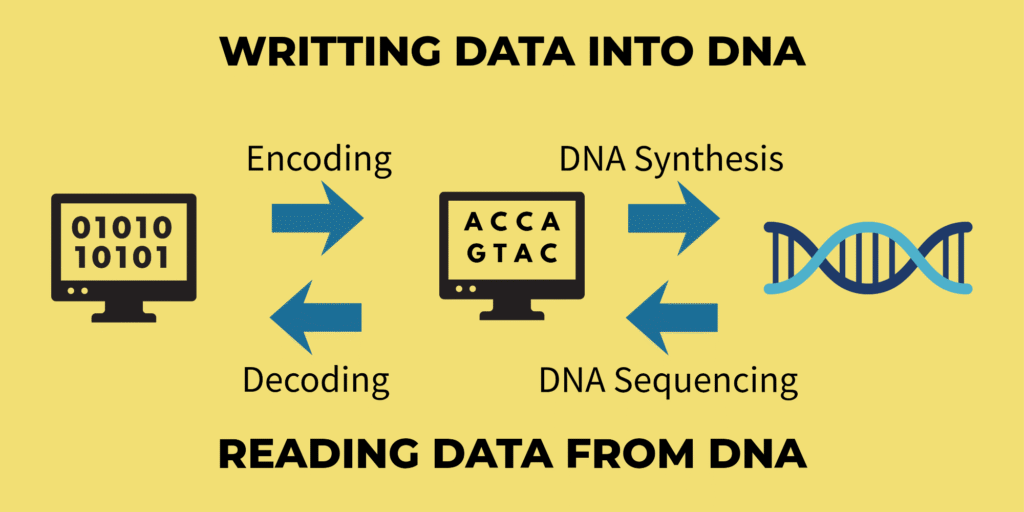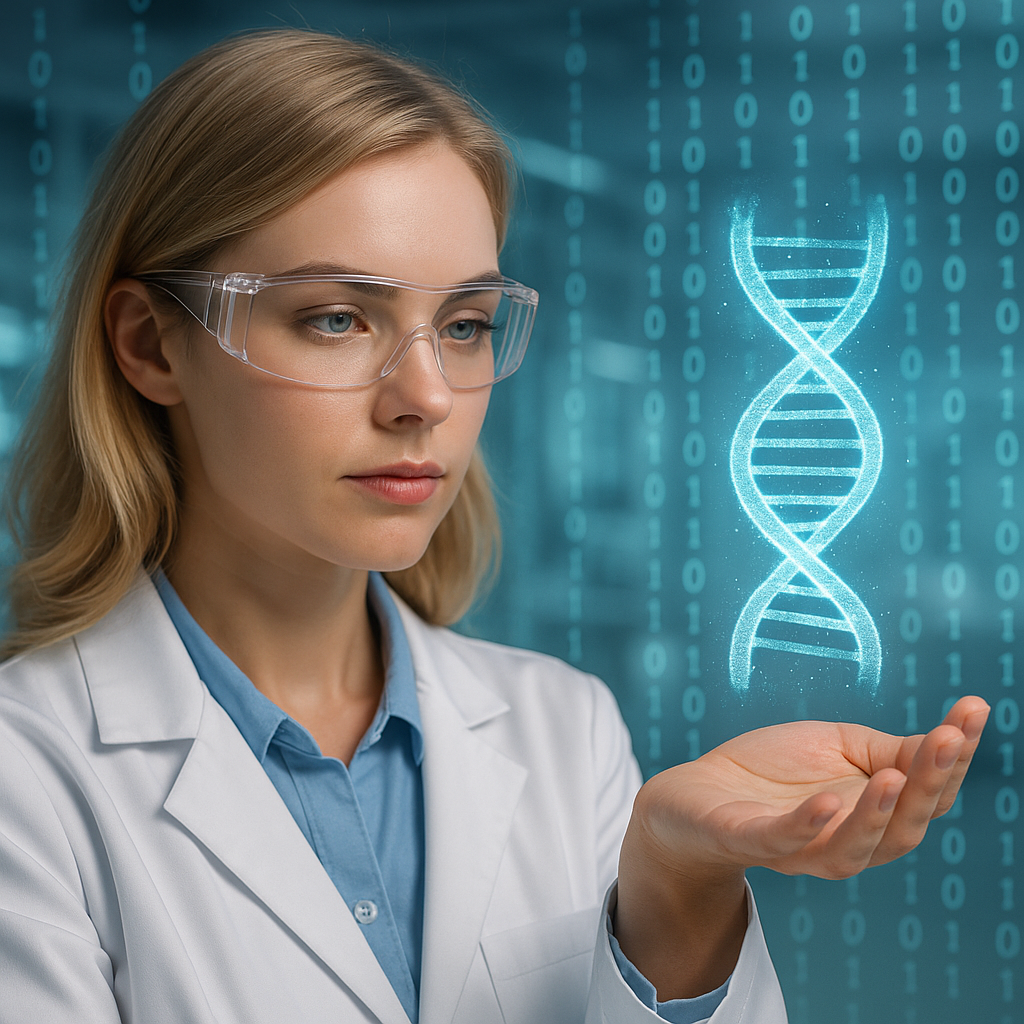Hard drives fade. DNA endures. Discover how scientists are turning life’s own code into the future of data storage—and maybe human memory itself.
DNA is the building block of life. Everything about you is stored in your DNA. A human genome has around 750 MB of data and surprisingly it is folded and coiled into a nucleus of a cell. So in short, nature has written and stored 750MB of data, i.e., the amount of data that fits in a CD, into a nucleus of a tiny cell that cannot even be seen with the naked eye.
Data explosion and its side effects
We’re creating more data in a single year than in all of human history before it — and running out of places to keep it.
In this digital age, data is the biggest weapon and also concerningly a less talked about issue, the biggest byproduct. Data could be anything like a photo you clicked, a tiktok you share, a financial transaction, heartbeat records on a smartwatch, super classified intelligence archives etc. All of them end up as 0s and 1s, clogging up our data centers.
U.S. National Academies of Sciences predicts the global data storage to surpass zettabytes and reach unfathomable yottabytes (1 trillion TB) by 2050.
Every byte we save costs metal, land, and power.
But our current storage methods are struggling to keep up with this kind of data. The real estate demands required to create enormous data centers will be huge.
As per International Energy Agency Report (2024), data centers globally consumed 415 TWh i.e., 1.5% of the electricity generated globally. Following this trend with our increasing data requirements, electricity demands for our data centers are expected to double by 2030.
The problem unfortunately doesn’t end here. The data centers need critical metals like cobalt, molybdenum and titanium which are environmentally costly to extract. The mining of these metals to meet our huge demands could lead to violence, wars and human rights violations.
Data centers generate large amounts of e-waste during each upgrade which occurs mostly after 5-7 years. Since the chips have a lot of materials mixed in it at a microscopic level, separating and recycling them is not an easy task. According to United Nations Global E-waste monitor 2024 , currently only less than 25% of the e-waste generated is actually recycled. The rest is processed informally or dumped into landfills.
In short, storing each byte of information has a cost to pay in metal, land and power.
The Discovery of DNA and the Idea of Information
The molecule that carries life’s code might soon carry the code of civilization.
A Swiss physician named Friedrich Miescher discovered DNA or deoxyribonucleic acid in 1869. At the time of discovery he didn’t know what it was. It was just a mysterious liquid extracted from the nucleus.
In 1944, Oswald Avery, Colin MacLeod, and Maclyn McCarty proved that DNA was the molecule of heredity.
In 1952, Alfred Hershey and Martha Chase confirmed that DNA had genetic material upon observing the viruses that injected its DNA into the bacteria.
In 1953, using X-ray diffraction data (Rosalind Franklin’s Photo 51 and base pairing rules (Chargaff’s rules), James Watson and Francis Crick proposed the double helix structure of DNA.
In 1959, Richard Feynman speculated storing information at molecular or atomic level in his lecture “There’s Plenty of Room at the Bottom”. It kind of planted a seed which was going to bloom later.
Decades later in 1988, an artist Joe Davis with the collaboration of Harvard Researchers encoded an image of a 35 bits runic symbol into the DNA of an E.coli bacterium. It was the first time someone had written a human artwork into a live DNA. It was revolutionary.
Fast forwarding to 2012, Harvard Genetics, George Church, Sri Kosuri and colleagues stored a 52000 word book, 11 images and a computer program into synthetic DNA. This was the first large scale digital to DNA encoding.
By 2023, a group of scientists built a DNA cassette tape. The idea is that strands of DNA can be arranged, read or overwritten just like a traditional cassette tape which can be read at a particular position and re-recorded.
In just a few decades, we have come a long way from discovering DNA to storing data in it.
How DNA Data Storage Works
DNA doesn’t just tell cells what to do — it can now tell computers what to remember.

We all know all the data in the digital universe is stored in 0s and 1s.
So the first step to store this data into DNA is to convert these 0s and 1s into DNA letters i.e., A, T, G and C. This is the first step and it’s called Encoding.
Step 1: Encoding
Think of encoding as changing the 0s and 1s into DNA letters as follows
00 -> A
01-> T
10-> G
11-> C
So for example a binary code such as 01101100 will be encoded as TGCA in DNA code.
Step 2: DNA Synthesis
Once the data is converted into DNA code, it is then physically built. This process is called DNA Synthesis. This is done using chemical or enzymatic reactions that link bases together in a precise sequence.
Now the data is sequenced to a small drop of DNA that is too small to be seen by the naked eye.
Step 3: Redundancy & error correction
DNA isn’t perfect. Reading and writing the DNA can sometimes create small damages to the DNA.
For example, imagine you are writing a big novel by hand. While writing it you might miss a few alphabets. And strangely, each time you read the novel some alphabets get damaged. This is what happens with DNA.
Since DNA synthesis and sequencing is very complicated these kinds of things usually happen.
So to prevent data loss, scientists make multiple copies of each strand through a process called coverage and add error-correction codes.
Now even if small damages occur, the system can still rebuild the data.
Step 4: Storing the DNA
The next step is to store the DNA. Unlike flash drives, DNA isn’t too bulky. A tiny vial of DNA could hold huge amounts of data.
It is estimated a gram of DNA can theoretically hold 200 pentabytes of data i.e., 200,000 TB of data.
If kept cool and dry, DNA can survive for thousands of years without any problems.
Step 5: DNA Sequencing
Reading the data in DNA is known as DNA Sequencing.
It is done by reading As, Cs, Gs and Ts in the order it was created. A computer then converts these to binary codes, reconstructing the file.
For example a DNA code “TGCA” will be read and converted to binary as 01101100.
Advantages of DNA storage
A coffee mug of DNA could hold all the data on Earth.
- Unbelievable data density
Data density of DNA is theoretically about 200 pentabytes per gram. A mid-sized data center can hold around 20 pentabytes of data. Even before the first transistors were invented, nature already had perfected data compression. - Longevity
Hard drives can survive only 5-10 years. After that they need to be replaced. DNA, on the other hand, can survive for thousands of years. Scientists have successfully sequenced DNA of Woolly Mammoths over 10000 years old and Neanderthal DNA of over 40000 years old. - No refrigeration
Data centers use large amounts of water, refrigerants and power for cooling purposes. This is not required when it comes to DNA. Once stored, it simply exists without an issue. - Eco friendly
Unlike hard drives that use rare metals, DNA is made from carbon, hydrogen, oxygen, nitrogen and phosphorus which make life itself. Switching just a fraction of data to DNA can drastically reduce e-waste.
Disadvantages of DNA Data Storage
Right now, storing a movie in DNA costs more than making the movie itself.
- Slow reading and writing speeds
Writing data in DNA is hundreds of millions of times slower than writing data to a hard drive. Similarly reading data from DNA is thousands of times slower than reading data from DNA. These speeds are totally impractical in today’s world. - Extremely expensive
It is extremely expensive to write data into DNA. Current synthesis rate is around $1000-$3000 per megabyte of data. The price needs to drop by a million times if it needs to compete with hard drives and cloud storage. - Energy and resource cost for production
Storing DNA doesn’t require much energy. But producing it requires lots of energy, reagents and enzymes.
The Road Ahead
Companies like Microsoft and Catalog are racing to make DNA storage faster and cheaper — the next hard drive may be a molecule.
Many forward thinking companies are already in the race to make DNA storage technology faster and cheaper.
Microsoft along with University of Washington has demonstrated a fully automated system to store and retrieve data from synthetic DNA.
CATALOG, a company by MIT researchers, is actively working on a way to make DNA storage cheaper.
Twist Bioscience Corporation, Illumina Inc. and Western Digital are also working with Microsoft to revolutionize DNA data storage.
There is also a lot of talk around the world when it comes to storing cold data. Cold data refers to information that isn’t regularly accessed. For example, old medical records, old transaction details, super classified intelligence archives etc. These data once stored are not going to be accessed regularly. But if stored in DNA could relieve a lot of data centers around the world.
Like the 1950s hard drives existed only in the lab, so is DNA technology today. It is costly and slow and needs scientists to write and read data on it. But in time everyday users are going to use it, write data in it and read data from it the way we use hard drives. Maybe DNA will be the next way we pass our knowledge and our history to the future generations.


The science sounds amazing. I would call it impractical maybe. But at $1,000 per MB, who’s paying for this? Until I can back up my photos in DNA without taking a loan, I’ll stick to Google Drive.
I think DNA storage is just some bulls**t companies have made up to raise money and keep investors.
Thank you for your comment. You are right about one thing. You might need a loan or may be loans depending on your credit score to backup.
But even the hard drive technology was costly back in the day. In 1956, a 15 MB, IBM 305 RAMAC weighing around 1 Ton, could be leased for $3200 per month(roughly $38000 in today’s money). Today we can’t imagine that kind of money for 15MB.
In the same way, companies are working on DNA data storage. May be by 2040-2050 we might be able to migrate our cold data to DNA and then years to come, we might be using it like hard drives of today.
Yes no one attest anything about the future. But what about this company CATALOG. I mean, they claimed they in 2019 that they would make DNA storing technology affordable in next 5-6 years. I’m not seeing any affordability as it is 2025.
Yes you are right. Catalog said in 2019 they would make DNA storage cheaper. They have actually made some really good progress actually. They have made a machine called Shannon that makes DNA writing faster and cheaper in the long run by using thousands of pre-made DNA fragments and mix them in different ways to represent data instead of printing each molecule. Obviously it’s not as cheap as backing data on your phone to cloud, but, it’s something.